Introduction:
Generative AI is revolutionizing software development, bringing innovation and efficiency to an industry that thrives on solving complex problems. By automating tedious tasks like code generation, testing, and bug detection, AI is helping developers work smarter, not harder. But its impact goes beyond just streamlining workflows—it’s reshaping how software is designed and created from the ground up.
Take GitHub Copilot, for example. This AI-powered coding assistant has become a valuable tool for developers, suggesting lines of code, entire functions, and even fixing errors in real-time. Such advancements reduce time spent on routine tasks, allowing developers to focus more on creative problem-solving and strategic decision-making.
Another industry benefitting from generative AI is healthcare, where AI systems help in creating custom software for patient management and diagnostics. By leveraging AI, companies are able to develop applications that adapt to ever-changing data inputs and provide faster, more accurate results—essential in life-saving contexts.
Key benefits of generative AI in software development include improved productivity, fewer coding errors, and faster time-to-market. Additionally, generative AI can analyze large datasets to identify patterns that guide the development of more efficient algorithms, further enhancing software performance.
In this article, we’ll explore how generative AI is shaping the future of software development, its practical applications across industries, and what developers can expect as AI becomes a key player in the creation of next-gen software.
Table of Contents
Accelerating Software Prototyping and Design
Generative AI is transforming how software prototypes and designs come to life, streamlining the entire process for developers and designers alike. By automating the creation of mockups and blueprints, AI-driven software design significantly speeds up the prototyping phase, allowing teams to iterate faster and bring their ideas to market more efficiently.
Companies like Figma are already leveraging AI to help designers quickly generate visual elements and layouts, drastically reducing the time it takes to build functional prototypes. Instead of manually sketching out every detail, designers can input high-level instructions, and the AI will generate detailed mockups that are ready for review or iteration. This shift not only accelerates the design process but also frees up creative energy, allowing teams to focus on refining ideas rather than executing tedious tasks.
One of the major benefits of generative AI for prototyping is the faster iteration cycles it enables. Developers can test various design options in a fraction of the time, gathering feedback and making adjustments without the usual lag between versions. Additionally, reduced design costs are a significant advantage, as teams can move through the design phase with fewer resources and quicker turnaround times.
By automating repetitive tasks, generative AI also improves creativity, giving designers the freedom to explore innovative concepts and bold ideas. As a result, AI-driven software design is not only more efficient but also more creative, producing prototypes that push the boundaries of traditional software development.
Enhancing Code Generation and Automation
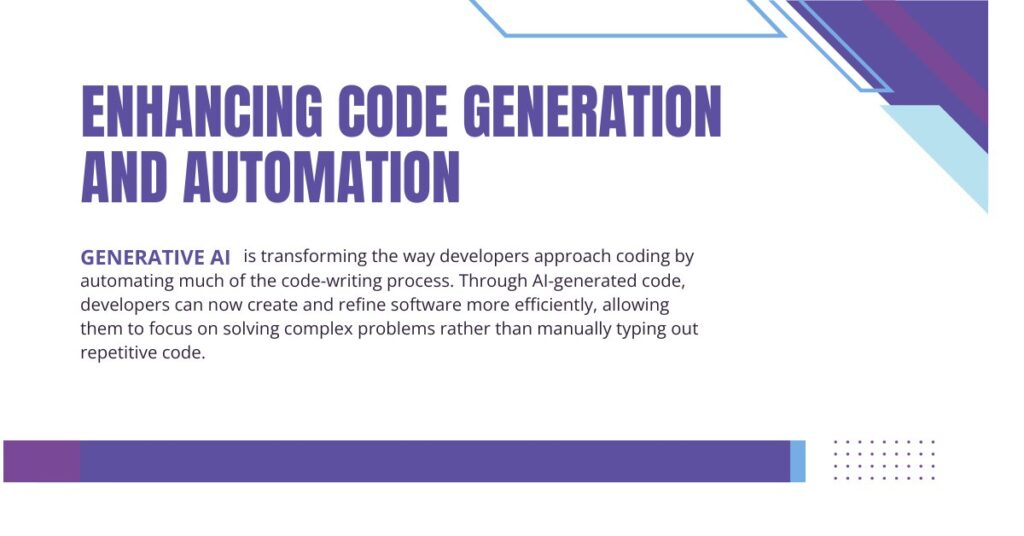
Platforms like GitHub Copilot, powered by OpenAI’s Codex, are leading the charge in this revolution. Copilot assists developers by suggesting entire code snippets, functions, or even completing entire blocks of code based on the developer’s input. This allows for faster development cycles, as teams can prototype, test, and iterate their software at a much quicker pace.
Another major benefit of automated code generation is the reduction in manual coding, which helps prevent common human errors. AI can analyze vast amounts of existing code to suggest solutions that are efficient and error-free. This not only saves time but also improves code quality, resulting in fewer bugs and cleaner code overall.
For example, Tabnine, another AI-powered tool, uses machine learning to predict and generate code that aligns with best practices. This makes it an invaluable resource for developers aiming to write scalable and reliable code without manually checking every line.
By automating code generation, generative AI enables developers to streamline their workflows, eliminate repetitive tasks, and spend more time on innovation. In the world of software development, AI-generated code is quickly becoming a game-changer, speeding up production while reducing errors.
To learn more about these platforms, check out GitHub Copilot and Tabnine, two leading tools reshaping the future of software development.
Reducing Development Costs and Time
Generative AI is playing a crucial role in reducing both the time and costs associated with software development. By automating repetitive tasks, streamlining workflows, and improving efficiency, AI allows development teams to focus on high-impact work while cutting down on unnecessary steps.
Take Microsoft, for instance, which has integrated AI into its software development processes. By leveraging AI tools to handle routine coding tasks, bug detection, and even code testing, Microsoft has significantly shortened its development cycles. This has led to faster time-to-market for new software, a critical advantage in the competitive tech industry.
One of the key benefits of using AI for cost-efficient software development is the reduction in manual labor. Tasks that previously required human intervention, like writing boilerplate code or running multiple test scenarios, can now be automated, saving time and reducing the need for larger development teams. AI reducing development time not only speeds up production but also allows businesses to allocate resources more efficiently, improving overall project management.
For example, companies like Amazon are using AI to optimize their development pipelines, ensuring that projects are completed faster and at a lower cost. By automating testing and deployment, they’ve minimized the risk of errors, resulting in fewer costly revisions down the road.
In short, generative AI is transforming how software is developed by making the process more cost-efficient and reducing time-to-market. As a result, companies can invest more in innovation and deliver high-quality products faster than ever before.
Improving Software Testing and Bug Detection
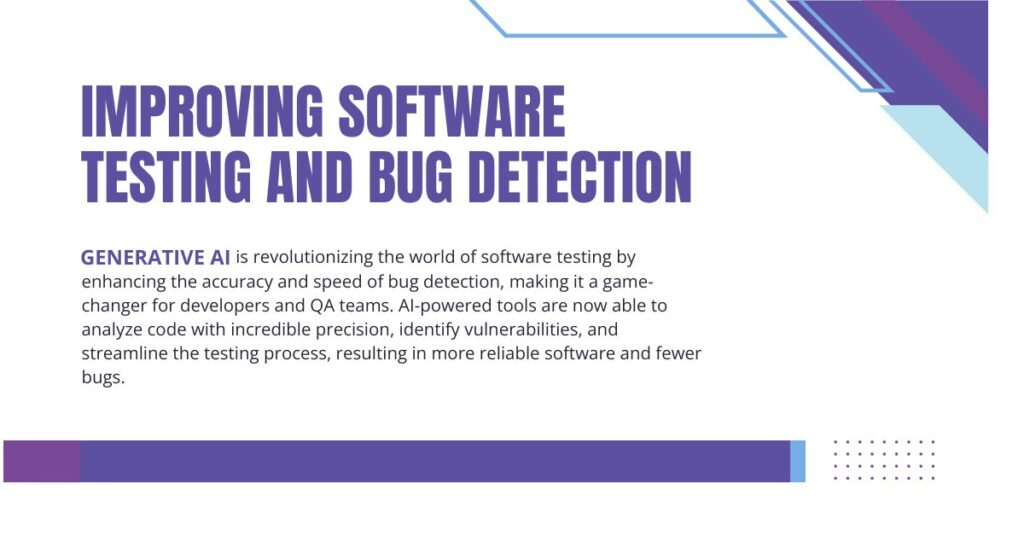
Platforms like Sentry and Testim are at the forefront of this AI-driven transformation. Sentry uses AI to monitor applications in real-time, automatically detecting and reporting errors before they impact users. This means bugs are identified and addressed more quickly, improving the overall reliability of the software. On the other hand, Testim leverages AI to create and maintain automated test scripts. Its AI algorithms can adapt to changes in the user interface, ensuring comprehensive test coverage and reducing the time needed for manual script updates.
One of the significant benefits of incorporating AI in software testing is increased test coverage. AI can simulate a wide range of scenarios and user interactions, which traditional testing methods might miss. This broader coverage ensures that more potential issues are caught early, enhancing the robustness of the software.
Moreover, AI-powered bug detection allows for faster bug identification and resolution. By automating the process of finding and diagnosing errors, AI reduces the time spent on manual testing, allowing developers to focus on fixing bugs and improving features.
In essence, generative AI is not just speeding up the testing process but also increasing its effectiveness, leading to more reliable software and a smoother user experience.
Boosting Creativity and Innovation in Development
Generative AI is a powerful catalyst for creativity in software development, pushing the boundaries of what’s possible by suggesting innovative solutions and novel approaches. By leveraging AI-driven innovation, developers can explore new ideas more freely, transforming the way software is conceived and built.
For instance, Adobe’s Sensei integrates AI into its Creative Cloud suite to assist designers in crafting unique visuals and layouts. It analyzes existing design patterns and offers suggestions that might not be immediately obvious to human designers. This ability to generate creative options quickly accelerates the brainstorming process, leading to more inventive and diverse design solutions.
Another compelling example is DeepMind, which uses AI to explore new algorithms and strategies for solving complex problems. By harnessing AI to generate and test various approaches, DeepMind has achieved breakthroughs in fields such as game theory and protein folding, demonstrating the vast potential of AI for creative problem-solving.
One of the key benefits of incorporating AI-driven innovation into development is the increased creativity it fosters. Developers and designers can leverage AI to experiment with different concepts and solutions, expanding their creative horizons. Additionally, AI facilitates faster brainstorming, enabling teams to generate and evaluate a wider range of ideas in less time.
Overall, generative AI is transforming creative software development by encouraging out-of-the-box thinking and streamlining the process of exploring innovative solutions. As AI continues to evolve, it will undoubtedly play an even more significant role in driving creativity and shaping the future of software development.
AI: The Secret Sauce to Supercharged CI/CD Pipelines
Imagine a world where software is deployed as seamlessly as pouring a glass of water. No more manual testing, no more late-night deployments, and no more sleepless nights worrying about bugs. Sounds like a dream, right? Well, thanks to the power of generative AI, this dream is becoming a reality.
How Does AI Enhance CI/CD?
Generative AI, with its ability to learn from vast datasets and generate new content, is revolutionizing the way we approach continuous integration and deployment (CI/CD). Here’s how:
- Smarter Code Reviews: AI-powered tools can analyze code changes, identify potential issues, and suggest improvements. This not only speeds up the review process but also ensures higher code quality.
- Predictive Testing: By analyzing historical data, AI can predict which test cases are more likely to fail. This allows teams to prioritize testing efforts and reduce the overall testing time.
- Automated Infrastructure Provisioning: AI can automatically provision and configure infrastructure based on application requirements. This eliminates manual errors and accelerates the deployment process.
- Intelligent Deployment Strategies: AI can analyze various factors, such as application load and system performance, to determine the optimal deployment strategy. This helps minimize downtime and ensure a smooth user experience.
Real-World Examples
- Netflix: Netflix uses AI to automate many aspects of its CI/CD pipeline, including testing, deployment, and monitoring. This has enabled them to release new features and updates more frequently.
- Spotify: Spotify leverages AI to predict which features are most likely to be used by users. This helps them prioritize development efforts and ensure that the most valuable features are delivered first.
Key Benefits of AI-Powered CI/CD
- Faster Releases: AI can automate many manual tasks, allowing teams to release software more frequently.
- Reduced Errors: AI can identify and prevent errors early in the development process, reducing the risk of costly defects.
- Improved Efficiency: AI can streamline workflows and optimize resource utilization, leading to increased efficiency and productivity.
- Enhanced Quality: AI can help ensure higher code quality and reliability, resulting in a better user experience.
As AI continues to evolve, we can expect to see even more innovative applications in the realm of CI/CD. By harnessing the power of AI, organizations can create more efficient, reliable, and scalable software delivery pipelines.
Customizing Software for Specific Business Needs
Generative AI is transforming the way businesses approach software customization by enabling the creation of tailored software solutions that meet specific needs. By leveraging AI to automate and personalize features based on user data, developers can create software that is not only functional but also perfectly aligned with individual business requirements.
Consider Salesforce, which utilizes AI to customize its CRM platform. With AI-driven software customization, Salesforce can analyze customer data and provide personalized recommendations and features. This means businesses can tailor their CRM systems to better fit their unique workflows, resulting in a more intuitive and effective tool. Similarly, Microsoft Azure’s AI helps companies build custom applications by automatically generating code snippets and integrating features that align with business goals.
The benefits of AI-driven software customization are substantial. Firstly, it leads to improved user satisfaction as the software better fits the specific needs of the business, enhancing user experience and productivity. Secondly, the flexibility of AI allows for rapid adjustments and updates, making the software highly adaptable to evolving business requirements. This adaptability is crucial in a fast-paced business environment where needs can change quickly.
Moreover, AI enables developers to create tailored software solutions with greater efficiency. Instead of starting from scratch, AI can generate customized code and features based on existing patterns and data, speeding up the development process and reducing costs.
In summary, generative AI is revolutionizing how businesses approach software development by providing tools that allow for precise customization and enhanced adaptability. This leads to more effective software solutions that align closely with business needs, ultimately driving greater satisfaction and operational efficiency.
Generative AI for Enhancing Collaboration Among Developers
Generative AI is reshaping how development teams collaborate, making it easier for developers to work together seamlessly. By automating code reviews, providing intelligent suggestions, and integrating real-time feedback, AI tools are revolutionizing team coding workflows and fostering better communication and efficiency.
One standout example is GitHub Copilot, which uses AI to assist developers by offering code suggestions and automatically reviewing code. This feature not only speeds up the coding process but also helps ensure consistency and quality across the codebase. When developers are working on a shared project, Copilot’s AI-driven suggestions can harmonize coding practices, reducing friction and aligning team members on best practices.
Similarly, CodeGuru by Amazon Web Services enhances collaboration by automating code reviews and providing actionable insights. It identifies potential issues and suggests improvements in real-time, allowing developers to address problems as they arise rather than waiting for a manual review. This leads to faster issue resolution and a smoother workflow, which is crucial for maintaining momentum in fast-paced development environments.
The key benefits of leveraging AI for developer collaboration include improved communication and smoother collaboration. AI tools facilitate more effective sharing of knowledge and coding practices, making it easier for teams to stay on the same page. Additionally, AI-driven tools reduce the time spent on manual tasks, allowing developers to focus on more strategic and creative aspects of their projects.
In essence, generative AI is enhancing team dynamics by automating routine tasks and providing valuable real-time feedback, leading to more efficient and effective collaboration among developers. As AI continues to advance, its role in facilitating team development will only become more integral to successful software projects.
Addressing Security and Compliance in AI-Driven Software Development
In the realm of software development, ensuring security and compliance is more critical than ever. Generative AI is stepping up to the challenge by enhancing software security and simplifying compliance with regulations. By automating security protocols and identifying vulnerabilities, AI tools are becoming indispensable in protecting data and ensuring adherence to regulatory standards.
Take Darktrace, for example, an AI-powered cybersecurity tool that uses machine learning to detect and respond to threats in real-time. Darktrace’s AI analyzes network activity to identify unusual behavior and potential vulnerabilities, providing early warnings and automated responses to mitigate risks. This proactive approach not only improves data security but also reduces the potential for costly breaches.
Another notable example is Veracode, which leverages AI to perform automated security scans and compliance checks. By integrating AI into the software development lifecycle, Veracode helps developers identify security flaws and compliance issues early, before they escalate into significant problems. This results in faster compliance audits and a more streamlined process for meeting regulatory requirements.
The key benefits of using AI in software security and AI-driven compliance include enhanced protection against cyber threats, reduced risk of data breaches, and more efficient compliance management. AI tools continuously monitor software for vulnerabilities, automate updates to security protocols, and ensure that compliance requirements are met, all while reducing the manual effort involved.
Challenges and Limitations of Generative AI in Development
While generative AI is revolutionizing software development, it’s not without its challenges and limitations. Understanding these issues is crucial for effectively integrating AI into development processes and ensuring its benefits are maximized while mitigating potential drawbacks.
One significant challenge is model bias, where AI systems can inadvertently reinforce existing prejudices present in their training data. For instance, Google’s AI-driven image recognition tools have faced criticism for racial and gender biases, highlighting the importance of addressing biases in AI models to prevent unfair outcomes. Companies must actively work to identify and correct these biases to ensure that AI systems make impartial decisions.
Another concern is the need for human oversight. While AI can automate many tasks, it often requires human intervention to interpret results, make ethical decisions, and handle complex scenarios that AI alone cannot fully understand. IBM’s Watson faced challenges in healthcare due to its inability to fully comprehend the nuances of medical diagnoses without substantial human input, demonstrating the need for a balanced approach where AI complements rather than replaces human expertise.
Scalability is also a crucial issue. Generative AI models can be resource-intensive and may not always scale efficiently across diverse applications. For example, OpenAI’s GPT-3 requires significant computational resources, which can limit its accessibility for smaller organizations or projects. This highlights the need for ongoing advancements in AI technology to improve scalability and reduce operational costs.
In summary, while generative AI offers tremendous potential, it also comes with AI challenges in development that need to be addressed. Issues such as model biases, the necessity for human oversight, and scalability concerns require careful management. Balancing the power of AI with thoughtful human intervention and continuous refinement of AI systems is essential for achieving the best outcomes in software development.
For more insights on AI challenges and best practices, check out these resources: Google AI and Bias, IBM Watson Health, and OpenAI GPT-3.
Research table
| Tool/Platform | Features | Benefits | Challenges | Examples/Use Cases | Sources/References |
|---|---|---|---|---|---|
| GitHub Copilot | AI-powered code suggestions, context-aware completions | Speeds up coding, reduces manual effort | May suggest suboptimal code, requires review | Used by developers for faster coding and code completion | GitHub Copilot |
| TabNine | Autocompletion, code snippets, multi-language support | Increases productivity, supports various languages | Limited to supported languages, privacy concerns | Integrated in IDEs to enhance coding efficiency | TabNine |
| DeepCode | AI-driven code review, bug detection | Improves code quality, identifies potential issues early | False positives, reliance on codebase quality | Used for automated code reviews and bug detection | DeepCode |
| Snyk | Vulnerability scanning, code security, dependency checks | Enhances security, integrates with CI/CD | May require configuration, potential for missed vulnerabilities | Used in CI/CD pipelines to ensure secure code | Snyk |
| CodeGuru | Automated code reviews, performance recommendations | Optimizes code performance, reduces manual review workload | Can be costly, requires integration effort | Employed by developers to improve code quality and performance | CodeGuru |
| Kite | Code completions, documentation generation | Enhances coding speed, provides contextual help | Can be intrusive, limited to certain IDEs | Helps developers with code suggestions and documentation | Kite |
| Jina AI | Neural search, AI-driven document processing | Facilitates advanced search capabilities, processes large datasets efficiently | Resource-intensive, complex setup | Applied in search and data processing applications | Jina AI |
| Rasa | Conversational AI, NLP-based chatbot creation | Enables development of intelligent chatbots, improves user interaction | Requires training data, can be complex to set up | Used for building AI-driven customer support systems | Rasa |
Key Insights:
- Tool Diversity: Different tools offer various functionalities such as code suggestions, automated reviews, or vulnerability scanning, catering to diverse aspects of the software development process.
- Benefits: Generative AI tools significantly enhance productivity and code quality, but they also come with challenges such as the need for human oversight and potential privacy concerns.
- Examples: The tools listed are widely used in the industry for improving different phases of software development, from coding to security.
FAQs
1. What is generative AI in the context of software development?
Generative AI refers to artificial intelligence systems that can create new content, such as code, based on patterns and data from existing information. In software development, it can automate tasks like code generation, debugging, and documentation, helping developers to streamline their workflows and improve efficiency.
2. How does generative AI improve software development processes?
Generative AI enhances software development by automating repetitive tasks, providing intelligent code suggestions, detecting vulnerabilities, and generating documentation. This leads to faster development cycles, improved code quality, and reduced manual effort, ultimately helping teams deliver software more efficiently.
3. Can generative AI tools replace human developers?
While generative AI tools significantly aid developers by automating various tasks and providing valuable insights, they are not a replacement for human expertise. AI tools complement human developers by handling routine tasks and offering suggestions, allowing developers to focus on more complex and creative aspects of software development.
4. What are some popular generative AI tools used in software development?
Popular generative AI tools include GitHub Copilot, which offers code completions and suggestions; DeepCode and CodeGuru, which automate code reviews and bug detection; and TabNine, which provides autocompletion for various programming languages. Each tool serves different purposes in the development process.
5. What are the challenges associated with using generative AI in software development?
Challenges include managing model biases that can lead to unintended consequences, requiring human oversight to ensure the AI’s suggestions are appropriate, and addressing scalability issues where AI models may be resource-intensive. Additionally, integrating AI tools into existing workflows can sometimes be complex and require careful implementation.
6. How does generative AI contribute to software security and compliance?
Generative AI enhances software security by automating vulnerability detection and compliance checks. Tools like Snyk and DeepCode use AI to scan code for security flaws and compliance issues, providing real-time feedback and improving overall data protection and adherence to regulatory standards.
7. What benefits can businesses expect from implementing generative AI in their software development processes?
Businesses can expect several benefits, including faster development cycles, improved code quality, reduced development costs, and enhanced security. Generative AI helps by automating routine tasks, providing valuable insights, and enabling more efficient workflows, ultimately leading to better software products and increased productivity.
8. Are there any privacy concerns with using generative AI tools?
Yes, privacy concerns can arise, especially when AI tools analyze sensitive code or data. It is crucial to choose AI tools that adhere to strong data protection practices and to ensure that any data used for training AI models is handled securely and in compliance with relevant regulations.
9. How can developers ensure they are using generative AI tools effectively?
Developers should combine AI tools with their own expertise to validate the AI’s suggestions and maintain oversight. Regularly updating and refining AI models, training the AI with diverse and high-quality data, and integrating AI tools into existing workflows thoughtfully can enhance their effectiveness and reliability.
10. What is the future outlook for generative AI in software development?
The future of generative AI in software development looks promising, with advancements expected to lead to even more powerful tools that can further automate and enhance various aspects of development. As AI technology evolves, it will continue to offer innovative solutions and improvements, driving greater efficiency and creativity in software development.
Conclusion: The Future of Generative AI in Software Development
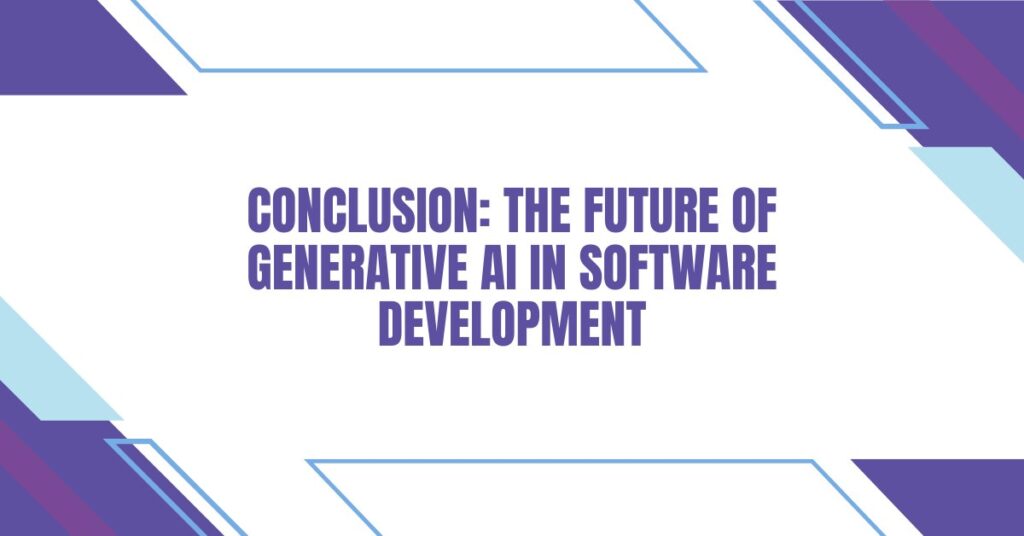
As we look towards the future, generative AI is poised to bring transformative changes to software development, continuing to push the boundaries of what’s possible in the tech industry. The evolution of AI technologies promises to further revolutionize the way we create, manage, and deploy software, opening up new opportunities and enhancing development processes.
One of the most exciting trends is the advancement of AI-driven automation, which will streamline repetitive tasks and significantly accelerate development cycles. Tools like GitHub Copilot and TabNine are just the beginning; future iterations will offer even more sophisticated capabilities, such as deeper contextual understanding and more personalized code suggestions. This will not only increase efficiency but also reduce the manual effort required in coding and debugging.
Enhanced innovation is another key benefit on the horizon. Generative AI is expected to drive new levels of creativity by suggesting novel solutions and optimizing designs in ways that were previously unimaginable. For instance, AI could help develop entirely new programming paradigms or architectures, pushing the envelope of what’s achievable in software development.
AI trends in development also indicate a greater focus on integrating AI tools seamlessly into CI/CD pipelines, enabling more robust and agile workflows. Companies are already exploring how AI can automate deployment processes and ensure continuous integration with minimal human intervention, which will lead to faster time-to-market and higher-quality software.
In summary, the future of AI in software development is incredibly promising. With ongoing advancements, we can anticipate a wave of innovations that will make development more efficient, creative, and adaptive. Embracing these changes will not only help developers stay ahead of the curve but also pave the way for groundbreaking software solutions that drive the next generation of technological progress.

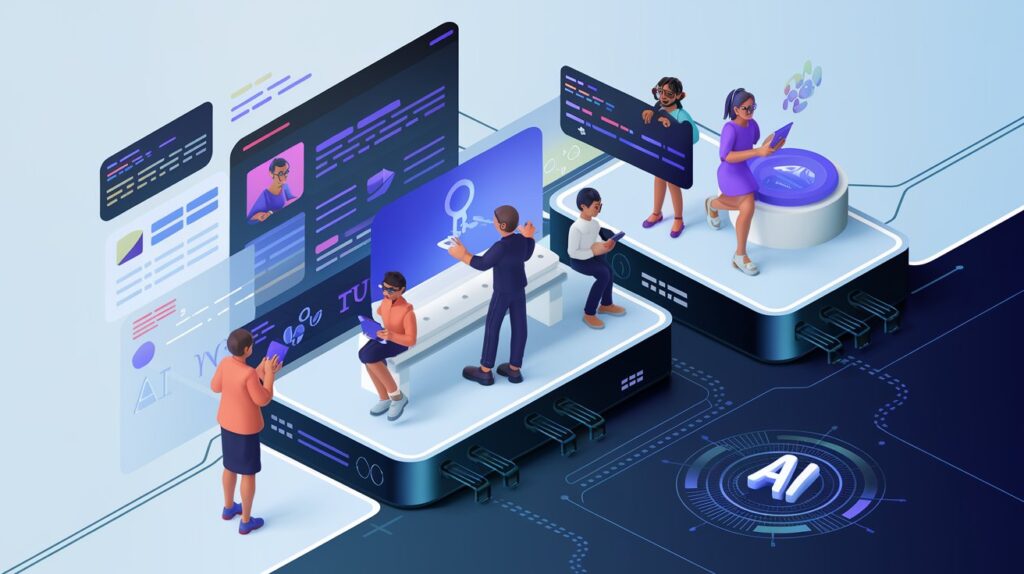
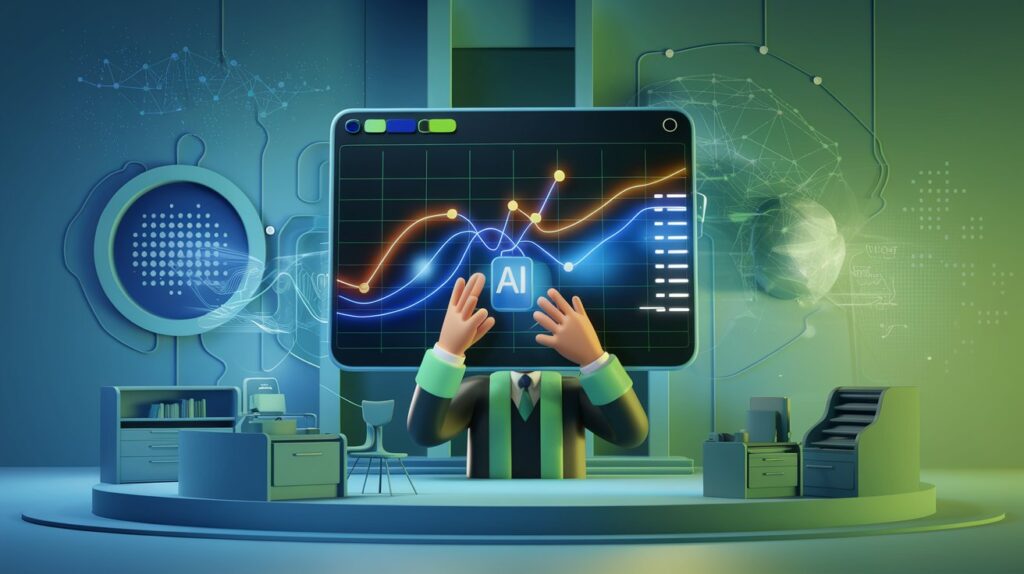
Pingback: Natural Language Processing vs Generative AI -